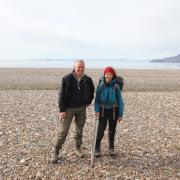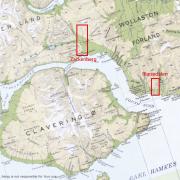Climate effects in terrestrial arctic ecosystems in Young Sund
Climate effects in terrestrial arctic ecosystems in Young Sund
The main objective of the project is to establish a plant monitoring programme in order to investigate how the diversity, functioning and composition of the terrestric ecosystems along the Young Sund are related to climatic variations. In addition to providing some of the first data on variations in plant community composition and arthropod diversity in the area, the study will provide a platform for long-term terrestric studies in the area. The project seeks to answer the following questions:
- How is the plant species distributions related altitude and to climatic changes along an East-West gradient in Young Sund, Greenland
- How is plant cover related to climate changes for the dominating plant species and functional groups in the same East-West gradient.
- How is the plant community composition related to altitude and local abiotic factors.
- How is the composition of the arthropod communities related to the same factors.
In order to answer these scientific questions we will establish permanent plots in randomly selected positions at fixed altitudes on three different stations along the Young Sund. The field work will take place in July–August 2014.
Field site: Zackenberg, N.E.Greenland
Fieldwork summary/photo blog
Participants:
AU: Jacob Nabe-Nielsen, Oskar L.P. Hansen and Laerke Stewart
GINR: Katrine Raundrup
Period: 14 Jul 2014 – 5 Aug 2014
Field site: Zackenberg and Blæsedalen both by Young Sund
Number of man-days used in field: Jacob: 15 days; Laerke: 21 days; Oskar: 28 days
Short summary, main achievements and difficulties encountered during field season:
We successfully established a large number of permanent plots on two different sites along Young Sund and conducted the planned vegetation analyses, soil measurements and insect sampling on both sites. Plots were selected following the same stratified random design as previously used in Godthåbsfjorden, with three groups of six plots in each altitude. In one site (Zackenberg) we established 108 plots on the isoclines 20, 100, 200, 300, 400 and 500 m above sea level. The other site (Blæsedalen) was only suitable for establishing plots up to 300 m a.s.l., so here only 72 plots were established. Unfortunately the field work progressed more slowly than anticipated due to late development of the vegetation caused by late snow melt. The identification of the underdeveloped, infertile plants was extraordinarily tricky. Further, we lost our tents during a storm in Blæsedalen, which caused a delay of several days, as we were forced to return to Zackenberg for safety reasons and to get new equipment. For this reason we had to deviate from our original plan of visiting three different sites along Young Sund, which is desirable for investigating the importance of the inland-ocean climate gradient. We hope to obtain the funding for establishing the plots on the last station (Tyrolerfjord) in 2015.

One of the common sedges of the area, Carex misandra (Photo: Jakob Nabe-Nielsen)

Laerke and Jacob heading out for field work in Blæsedalen, at the Eastern end of the Young Sund (Photo: Jacob Nabe-Nielsen)

Approximate location of the two field sites were permanent plots were established in 2014 (Photo: NunaGIS)





